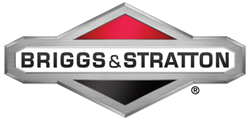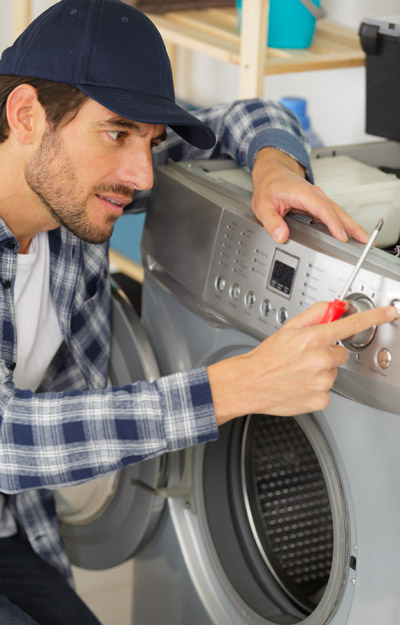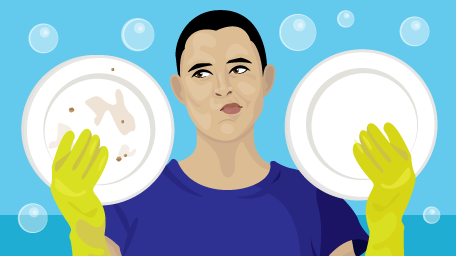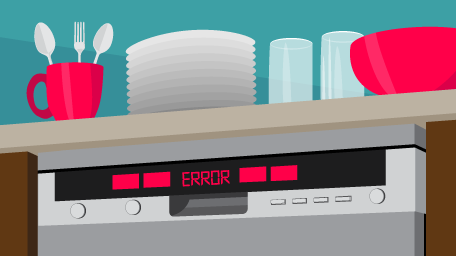Make sure you haven't got the discount earlier.

How to Clean a Bosch Dishwasher
Regularly cleaning your Bosch dishwasher not only helps prevent buildup of grime, limescale, and food particles but also ensures your dishes come out sparkling clean every time. If you do not clean your dishwasher the right way, you may end up with unpleasant odors and blockages in the drainage system. This guide will show you the most efficient way to clean your dishwasher filter, tub, spray arms, door seals, and outer panel. By following these tips, you can keep your dishwasher smelling fresh and enjoy clean dishes with every wash cycle.
How to Clean a Bosch Dishwasher Exterior
The exterior or outer panel of the dishwasher can accumulate dust, dirt, and food splatters. Regular cleaning helps prevent the buildup of grime and reduces the risk of bacteria growth. It also prevents corrosion and deterioration of the exterior surfaces, ensuring your appliance remains in good condition for years to come. A clean exterior can also enhance the overall appearance of your kitchen!
- Ensure the dishwasher is turned off and unplugged before you start cleaning.
- Prepare a cleaning solution by mixing dish soap with warm water.
- Dip a cloth or sponge into the soapy water and wipe down the door panel of the dishwasher, focusing on any dirty spots or fingerprints.
- Use a lightly dampened cloth to wipe the control panel as well and gently clean around the buttons. Be careful not to use excessive water.
- Once you are done, rinse the area with a damp cloth to remove any residue.
- Dry the surface and ensure there is no moisture left.
- If your dishwasher has a stainless steel exterior, apply a stainless steel cleaner or a mixture of white vinegar and water and wipe in the direction of the grain to avoid streaks and create a smooth, glossy finish.
How to Remove Dishwasher Smells and Limescale Using Vinegar and Baking Soda
Over time, food particles, grease, and soap scum can accumulate inside the tub, leading to a smelly dishwasher, reduced cleaning efficiency, and potentially harmful bacteria growth. It is best to perform a tub cleaning every month to help prevent these issues and ensure that your dishwasher effectively cleans your dishes. You can purchase a commercial cleaner and follow the manufacturer's instructions to clean your dishwasher tub, or you can make your own cleaner using vinegar and baking soda. Vinegar is acidic, which helps dissolve limescale and mineral deposits that can build up inside the dishwasher over time, especially if you have hard water. Baking soda acts as a gentle abrasive and helps in removing stubborn stains and residue. Both vinegar and baking soda also neutralize unpleasant dishwasher smells which makes them a popular choice for many household owners.
- Disconnect the dishwasher from the power supply and ensure there are no dishes or utensils inside the dishwasher.
- Pour about one cup of white vinegar into a dishwasher-safe cup or bowl.
- Place the cup or bowl filled with vinegar on the top rack of the dishwasher. This ensures that the vinegar is evenly distributed throughout the dishwasher during the cleaning cycle.
- Close the dishwasher door and select a regular wash cycle or a hot water cycle, depending on your dishwasher’s settings.
- Start the dishwasher and let it run through the entire cycle. The hot water, combined with the vinegar, will help break down any grease, grime, and tough stains.
- Once the cycle is complete, open the dishwasher and let it cool down for a few minutes.
- Inspect the interior of the dishwasher. If there are any remaining spots or residue, use a cloth or sponge to wipe them down. You can also use a soft brush or toothbrush for hard-to-reach spots.
- After the vinegar cycle, sprinkle a cup of baking soda on the bottom of the dishwasher. This will help neutralize odors and further clean the interior.
- Run a short hot water cycle.
- After the baking soda cycle is complete, open the dishwasher and let it cool down for a few minutes. You can leave the door slightly ajar to allow fresh air to circulate through.
How to Clean a Bosch Dishwasher Filter
The filter is responsible for trapping food particles, debris, and other materials that are released during the wash cycle. Over time, these trapped food particles can accumulate and clog the filter, leading to reduced water flow, and unpleasant dishwasher smells. A clogged filter will also cause dirty water to be recirculated in the washer, resulting in poor cleaning results. Regularly cleaning the filter helps prevent buildup, ensures proper drainage, and maintains the dishwasher's efficiency, resulting in clean dishes with each wash cycle. It is recommended to clean the filter every 1- 3 months for best results. If your filter is no longer in good working condition, you will need to find a replacement dishwasher filter to keep your dishwasher running efficiently.
- Turn off the dishwasher and disconnect it from the water supply.
- Open the dishwasher door and pull out the lower rack and spray arm.
- You can find the filter at the bottom of the dishwasher tub. Carefully twist the filter out of the mounting bracket to clean it.
- Rinse the filter under warm running water to get rid of any food debris and residue.
- Use a soft brush and dish soap to scrub the filter clean. Avoid harsh cleaners as these may damage the filter.
- Wipe or scrub the filter mounting area and ensure it is clean before returning the filter.
- Press the filter back into place and reattach the spray arm.
- Carefully slide the lower rack back into place and resume use of your dishwasher.
How to Clean Bosch Dishwasher Spray Arms
Spray arms are designed to distribute water throughout the dishwasher during the cleaning cycle. Over time, they can become clogged with food particles, mineral deposits, or other debris. This hinders water flow and negatively affects the cleaning performance of the dishwasher. Cleaning the spray arms every 3 months helps to ensure that water can freely flow through the nozzles, allowing for optimal cleaning and prevention of poor drainage and lingering odors.
- Disconnect the dishwasher from the power outlet for your safety.
- Open the dishwasher and slide the upper rack out.
- Press on the locking tab or clip that secures the upper spray arm to the underside of the rack and pull off the spray arm.
- Return to the dishwasher and slide the lower rack all the way out as well.
- Grip the lower spray arm and pull it upwards to detach it from the mounting bracket.
- Rinse both arms under running water to clear any loose debris.
- If there is stubborn residue or mineral buildup, soak the spray arms in warm, soapy water for about 15-20 minutes.
- After soaking, use a soft brush to scrub the spray arms and rinse them thoroughly to remove any remaining debris or soap.
- Use a toothpick or small brush to clear out any clogged holes.
- Reattach the upper spray arms to the upper rack and return it to the dishwasher.
- Snap the lower spray arm back onto the mounting bracket at the bottom of the dishwasher.
- Slide the lower rack back into place and restore the power to the appliance.
How to Clean Bosch Dishwasher Door Seals
The door seals are responsible for creating a tight seal when the dishwasher door is closed to prevent water from leaking out during the wash cycle. However, the door seals are prone to trapping moisture, food particles, and detergent residue which create an ideal environment for mold and mildew to grow. Regularly cleaning the door seals helps prevent the buildup of these contaminants, which can cause your dishwasher to smell bad and potentially damage the door seals, leading to leakages and water damage. It is recommended to clean the door seals on a monthly basis. If the seals are damaged, loose, or worn down, it is best to find a replacement door seal for your Bosch dishwasher.
- Ensure the dishwasher is turned off and unplugged for safety.
- Mix mild dish soap with warm water. Or mix a solution of equal parts white vinegar and warm water for extra disinfecting power.
- Open the dishwasher door to access the door seals. Look for any visible dirt, grime, or mold.
- Use a cloth or sponge to wipe down the entire length of the door seals, making sure to clean both the top and sides.
- Use a toothbrush or small soft brush for hard-to-reach areas or stubborn stains.
- Dampen a clean cloth with water and wipe down the seals to remove any soap or vinegar residue.
- Use a dry microfiber cloth to thoroughly dry the seals. This helps to prevent mold and mildew growth.
How to Maintain Your Bosch Dishwasher
- Do not overload your dishwasher as this reduces its cleaning efficiency.
- Remove large food particles from the dishes before loading them in the dishwasher to reduce the risk of blockages.
- Use the correct amount of dish detergent. Using too much detergent can result in excessive soap residue which increases the risk of bacterial growth.
- Remove any remaining food debris from the dishwasher tub after each wash.
- Avoid using abrasive cleaners or scouring pads to clean your dishwasher as they can scratch the surfaces and lead to premature wear down.
- If you have hard water, use a water softener or add a dishwasher salt to help prevent mineral buildup.
Regularly maintaining and cleaning your Bosch dishwasher is essential for ensuring its longevity, efficiency, and the cleanliness of your dishes. By tackling limescale and grease buildup, you can keep your appliance in peak condition. Not only does this prevent buildup and unpleasant dishwasher smells, but it also ensures your dishwasher operates at its best, providing sparkling results every time. Remember, a well-maintained dishwasher saves energy, reduces the need for repairs, and contributes to a more hygienic kitchen environment. Taking the time to care for your Bosch dishwasher will pay off with years of reliable and efficient performance.





























